Workforce Planning Report: JKL Industries - HR Strategies
VerifiedAdded on 2020/04/15
|9
|2598
|60
Report
AI Summary
This report provides a comprehensive workforce planning analysis for JKL Industries, focusing on HR strategies and workforce management. The report begins with a case study scenario, examining the company's workforce requirements and the factors affecting supply, including internal labor resources, external labor markets, and product demand. It reviews current staff turnover data and demographics from the appendix, projecting future workforce needs and identifying external factors influencing supply, such as market conditions, competition, and government policies. The report addresses industrial relations information, including worker rights and responsibilities, and relevant government policies. It then outlines a communication strategy for different stakeholders, including senior management, line management, and workers. Finally, it details a risk management and contingency plan to mitigate potential workforce-related challenges, offering recommendations for improving workforce culture, diversity, and skill development, alongside proposed strategies for achieving specific objectives, such as sourcing and retaining skilled labor, and promoting workforce diversity.
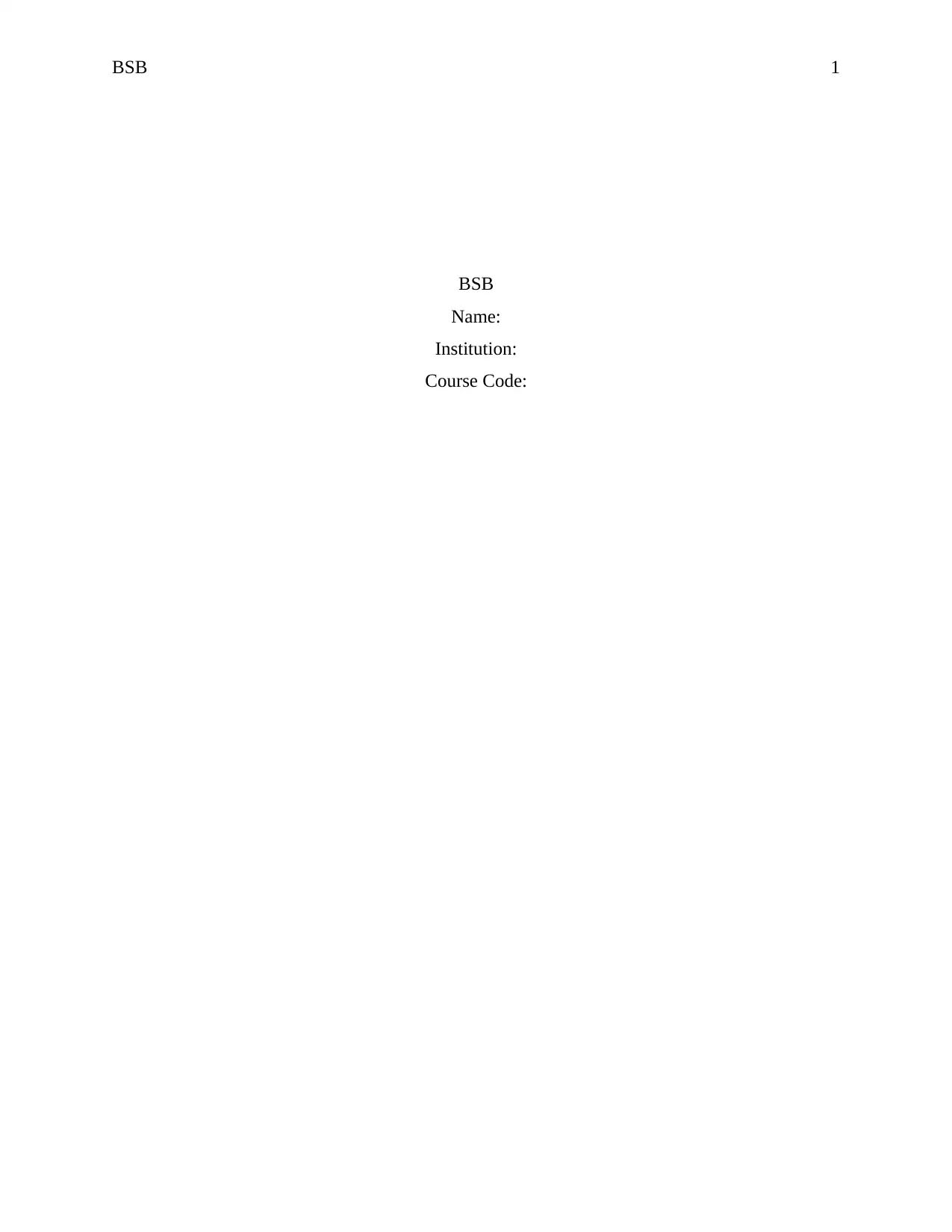
BSB 1
BSB
Name:
Institution:
Course Code:
BSB
Name:
Institution:
Course Code:
Paraphrase This Document
Need a fresh take? Get an instant paraphrase of this document with our AI Paraphraser
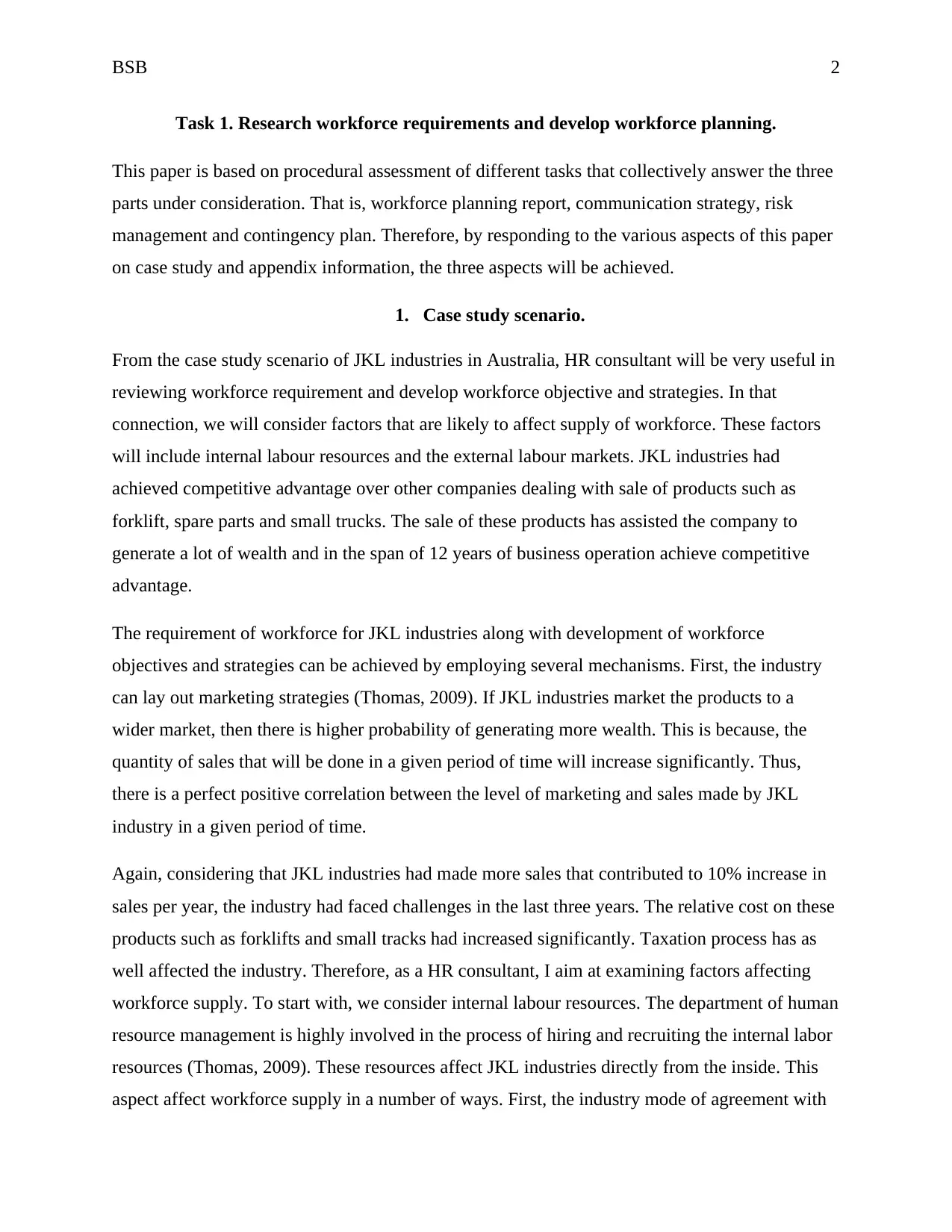
BSB 2
Task 1. Research workforce requirements and develop workforce planning.
This paper is based on procedural assessment of different tasks that collectively answer the three
parts under consideration. That is, workforce planning report, communication strategy, risk
management and contingency plan. Therefore, by responding to the various aspects of this paper
on case study and appendix information, the three aspects will be achieved.
1. Case study scenario.
From the case study scenario of JKL industries in Australia, HR consultant will be very useful in
reviewing workforce requirement and develop workforce objective and strategies. In that
connection, we will consider factors that are likely to affect supply of workforce. These factors
will include internal labour resources and the external labour markets. JKL industries had
achieved competitive advantage over other companies dealing with sale of products such as
forklift, spare parts and small trucks. The sale of these products has assisted the company to
generate a lot of wealth and in the span of 12 years of business operation achieve competitive
advantage.
The requirement of workforce for JKL industries along with development of workforce
objectives and strategies can be achieved by employing several mechanisms. First, the industry
can lay out marketing strategies (Thomas, 2009). If JKL industries market the products to a
wider market, then there is higher probability of generating more wealth. This is because, the
quantity of sales that will be done in a given period of time will increase significantly. Thus,
there is a perfect positive correlation between the level of marketing and sales made by JKL
industry in a given period of time.
Again, considering that JKL industries had made more sales that contributed to 10% increase in
sales per year, the industry had faced challenges in the last three years. The relative cost on these
products such as forklifts and small tracks had increased significantly. Taxation process has as
well affected the industry. Therefore, as a HR consultant, I aim at examining factors affecting
workforce supply. To start with, we consider internal labour resources. The department of human
resource management is highly involved in the process of hiring and recruiting the internal labor
resources (Thomas, 2009). These resources affect JKL industries directly from the inside. This
aspect affect workforce supply in a number of ways. First, the industry mode of agreement with
Task 1. Research workforce requirements and develop workforce planning.
This paper is based on procedural assessment of different tasks that collectively answer the three
parts under consideration. That is, workforce planning report, communication strategy, risk
management and contingency plan. Therefore, by responding to the various aspects of this paper
on case study and appendix information, the three aspects will be achieved.
1. Case study scenario.
From the case study scenario of JKL industries in Australia, HR consultant will be very useful in
reviewing workforce requirement and develop workforce objective and strategies. In that
connection, we will consider factors that are likely to affect supply of workforce. These factors
will include internal labour resources and the external labour markets. JKL industries had
achieved competitive advantage over other companies dealing with sale of products such as
forklift, spare parts and small trucks. The sale of these products has assisted the company to
generate a lot of wealth and in the span of 12 years of business operation achieve competitive
advantage.
The requirement of workforce for JKL industries along with development of workforce
objectives and strategies can be achieved by employing several mechanisms. First, the industry
can lay out marketing strategies (Thomas, 2009). If JKL industries market the products to a
wider market, then there is higher probability of generating more wealth. This is because, the
quantity of sales that will be done in a given period of time will increase significantly. Thus,
there is a perfect positive correlation between the level of marketing and sales made by JKL
industry in a given period of time.
Again, considering that JKL industries had made more sales that contributed to 10% increase in
sales per year, the industry had faced challenges in the last three years. The relative cost on these
products such as forklifts and small tracks had increased significantly. Taxation process has as
well affected the industry. Therefore, as a HR consultant, I aim at examining factors affecting
workforce supply. To start with, we consider internal labour resources. The department of human
resource management is highly involved in the process of hiring and recruiting the internal labor
resources (Thomas, 2009). These resources affect JKL industries directly from the inside. This
aspect affect workforce supply in a number of ways. First, the industry mode of agreement with
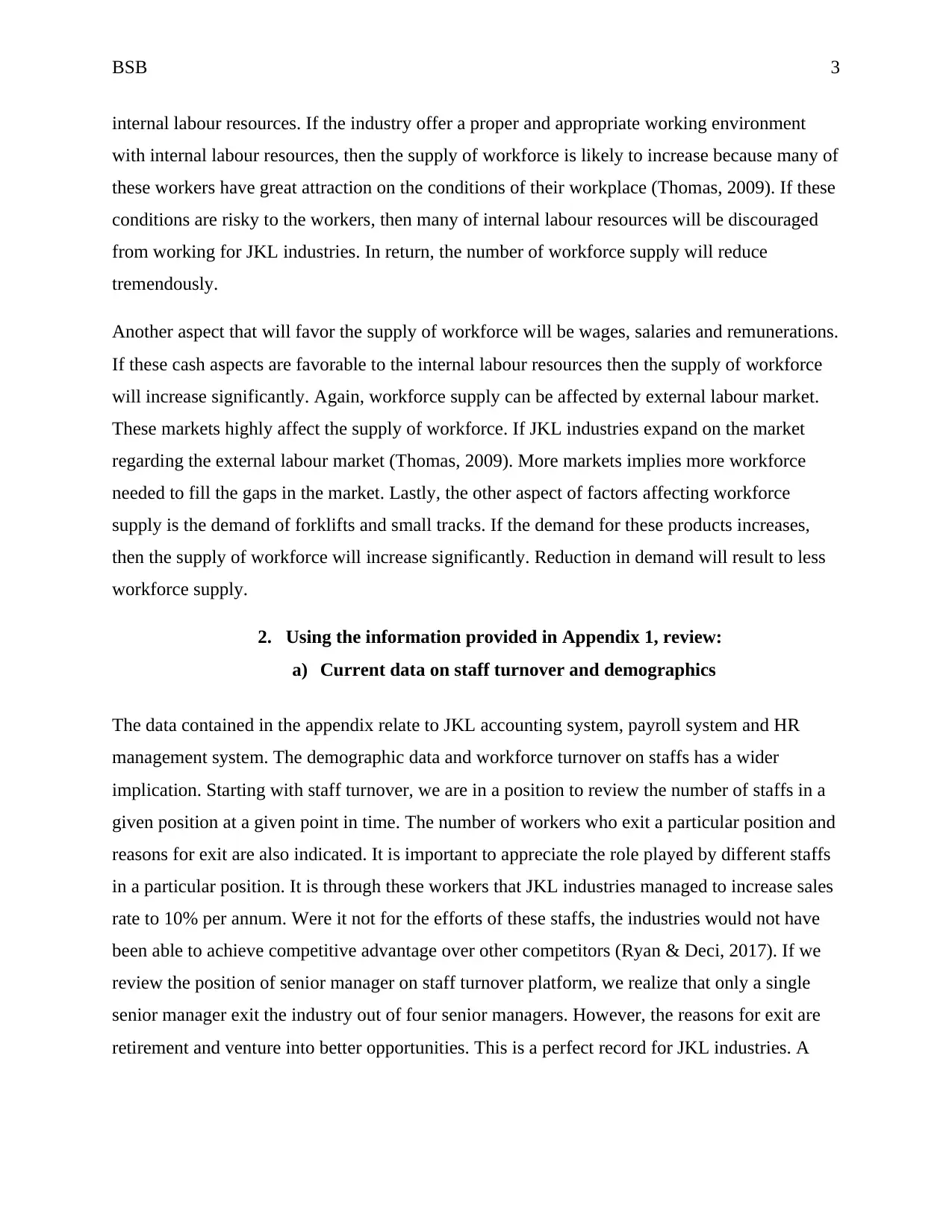
BSB 3
internal labour resources. If the industry offer a proper and appropriate working environment
with internal labour resources, then the supply of workforce is likely to increase because many of
these workers have great attraction on the conditions of their workplace (Thomas, 2009). If these
conditions are risky to the workers, then many of internal labour resources will be discouraged
from working for JKL industries. In return, the number of workforce supply will reduce
tremendously.
Another aspect that will favor the supply of workforce will be wages, salaries and remunerations.
If these cash aspects are favorable to the internal labour resources then the supply of workforce
will increase significantly. Again, workforce supply can be affected by external labour market.
These markets highly affect the supply of workforce. If JKL industries expand on the market
regarding the external labour market (Thomas, 2009). More markets implies more workforce
needed to fill the gaps in the market. Lastly, the other aspect of factors affecting workforce
supply is the demand of forklifts and small tracks. If the demand for these products increases,
then the supply of workforce will increase significantly. Reduction in demand will result to less
workforce supply.
2. Using the information provided in Appendix 1, review:
a) Current data on staff turnover and demographics
The data contained in the appendix relate to JKL accounting system, payroll system and HR
management system. The demographic data and workforce turnover on staffs has a wider
implication. Starting with staff turnover, we are in a position to review the number of staffs in a
given position at a given point in time. The number of workers who exit a particular position and
reasons for exit are also indicated. It is important to appreciate the role played by different staffs
in a particular position. It is through these workers that JKL industries managed to increase sales
rate to 10% per annum. Were it not for the efforts of these staffs, the industries would not have
been able to achieve competitive advantage over other competitors (Ryan & Deci, 2017). If we
review the position of senior manager on staff turnover platform, we realize that only a single
senior manager exit the industry out of four senior managers. However, the reasons for exit are
retirement and venture into better opportunities. This is a perfect record for JKL industries. A
internal labour resources. If the industry offer a proper and appropriate working environment
with internal labour resources, then the supply of workforce is likely to increase because many of
these workers have great attraction on the conditions of their workplace (Thomas, 2009). If these
conditions are risky to the workers, then many of internal labour resources will be discouraged
from working for JKL industries. In return, the number of workforce supply will reduce
tremendously.
Another aspect that will favor the supply of workforce will be wages, salaries and remunerations.
If these cash aspects are favorable to the internal labour resources then the supply of workforce
will increase significantly. Again, workforce supply can be affected by external labour market.
These markets highly affect the supply of workforce. If JKL industries expand on the market
regarding the external labour market (Thomas, 2009). More markets implies more workforce
needed to fill the gaps in the market. Lastly, the other aspect of factors affecting workforce
supply is the demand of forklifts and small tracks. If the demand for these products increases,
then the supply of workforce will increase significantly. Reduction in demand will result to less
workforce supply.
2. Using the information provided in Appendix 1, review:
a) Current data on staff turnover and demographics
The data contained in the appendix relate to JKL accounting system, payroll system and HR
management system. The demographic data and workforce turnover on staffs has a wider
implication. Starting with staff turnover, we are in a position to review the number of staffs in a
given position at a given point in time. The number of workers who exit a particular position and
reasons for exit are also indicated. It is important to appreciate the role played by different staffs
in a particular position. It is through these workers that JKL industries managed to increase sales
rate to 10% per annum. Were it not for the efforts of these staffs, the industries would not have
been able to achieve competitive advantage over other competitors (Ryan & Deci, 2017). If we
review the position of senior manager on staff turnover platform, we realize that only a single
senior manager exit the industry out of four senior managers. However, the reasons for exit are
retirement and venture into better opportunities. This is a perfect record for JKL industries. A
⊘ This is a preview!⊘
Do you want full access?
Subscribe today to unlock all pages.

Trusted by 1+ million students worldwide
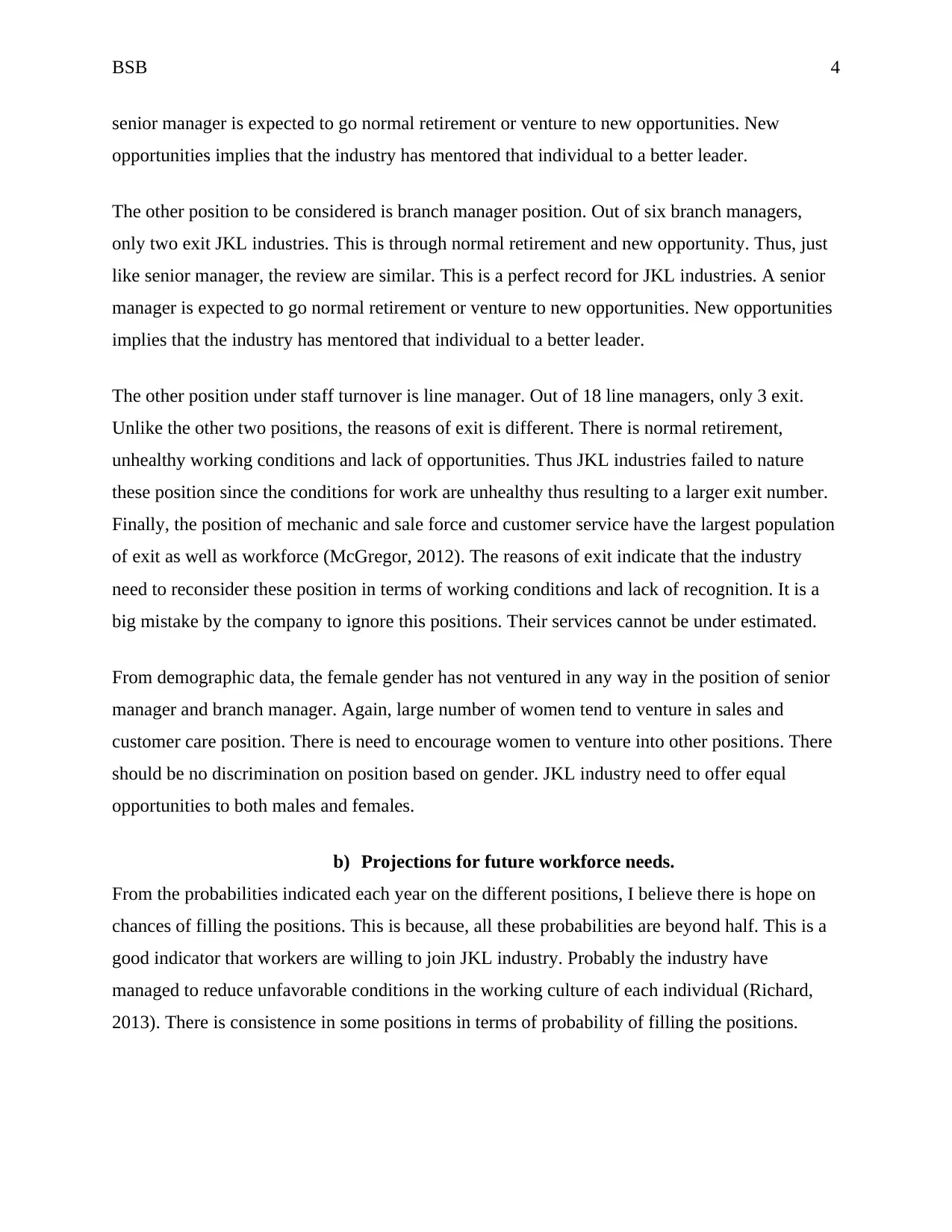
BSB 4
senior manager is expected to go normal retirement or venture to new opportunities. New
opportunities implies that the industry has mentored that individual to a better leader.
The other position to be considered is branch manager position. Out of six branch managers,
only two exit JKL industries. This is through normal retirement and new opportunity. Thus, just
like senior manager, the review are similar. This is a perfect record for JKL industries. A senior
manager is expected to go normal retirement or venture to new opportunities. New opportunities
implies that the industry has mentored that individual to a better leader.
The other position under staff turnover is line manager. Out of 18 line managers, only 3 exit.
Unlike the other two positions, the reasons of exit is different. There is normal retirement,
unhealthy working conditions and lack of opportunities. Thus JKL industries failed to nature
these position since the conditions for work are unhealthy thus resulting to a larger exit number.
Finally, the position of mechanic and sale force and customer service have the largest population
of exit as well as workforce (McGregor, 2012). The reasons of exit indicate that the industry
need to reconsider these position in terms of working conditions and lack of recognition. It is a
big mistake by the company to ignore this positions. Their services cannot be under estimated.
From demographic data, the female gender has not ventured in any way in the position of senior
manager and branch manager. Again, large number of women tend to venture in sales and
customer care position. There is need to encourage women to venture into other positions. There
should be no discrimination on position based on gender. JKL industry need to offer equal
opportunities to both males and females.
b) Projections for future workforce needs.
From the probabilities indicated each year on the different positions, I believe there is hope on
chances of filling the positions. This is because, all these probabilities are beyond half. This is a
good indicator that workers are willing to join JKL industry. Probably the industry have
managed to reduce unfavorable conditions in the working culture of each individual (Richard,
2013). There is consistence in some positions in terms of probability of filling the positions.
senior manager is expected to go normal retirement or venture to new opportunities. New
opportunities implies that the industry has mentored that individual to a better leader.
The other position to be considered is branch manager position. Out of six branch managers,
only two exit JKL industries. This is through normal retirement and new opportunity. Thus, just
like senior manager, the review are similar. This is a perfect record for JKL industries. A senior
manager is expected to go normal retirement or venture to new opportunities. New opportunities
implies that the industry has mentored that individual to a better leader.
The other position under staff turnover is line manager. Out of 18 line managers, only 3 exit.
Unlike the other two positions, the reasons of exit is different. There is normal retirement,
unhealthy working conditions and lack of opportunities. Thus JKL industries failed to nature
these position since the conditions for work are unhealthy thus resulting to a larger exit number.
Finally, the position of mechanic and sale force and customer service have the largest population
of exit as well as workforce (McGregor, 2012). The reasons of exit indicate that the industry
need to reconsider these position in terms of working conditions and lack of recognition. It is a
big mistake by the company to ignore this positions. Their services cannot be under estimated.
From demographic data, the female gender has not ventured in any way in the position of senior
manager and branch manager. Again, large number of women tend to venture in sales and
customer care position. There is need to encourage women to venture into other positions. There
should be no discrimination on position based on gender. JKL industry need to offer equal
opportunities to both males and females.
b) Projections for future workforce needs.
From the probabilities indicated each year on the different positions, I believe there is hope on
chances of filling the positions. This is because, all these probabilities are beyond half. This is a
good indicator that workers are willing to join JKL industry. Probably the industry have
managed to reduce unfavorable conditions in the working culture of each individual (Richard,
2013). There is consistence in some positions in terms of probability of filling the positions.
Paraphrase This Document
Need a fresh take? Get an instant paraphrase of this document with our AI Paraphraser
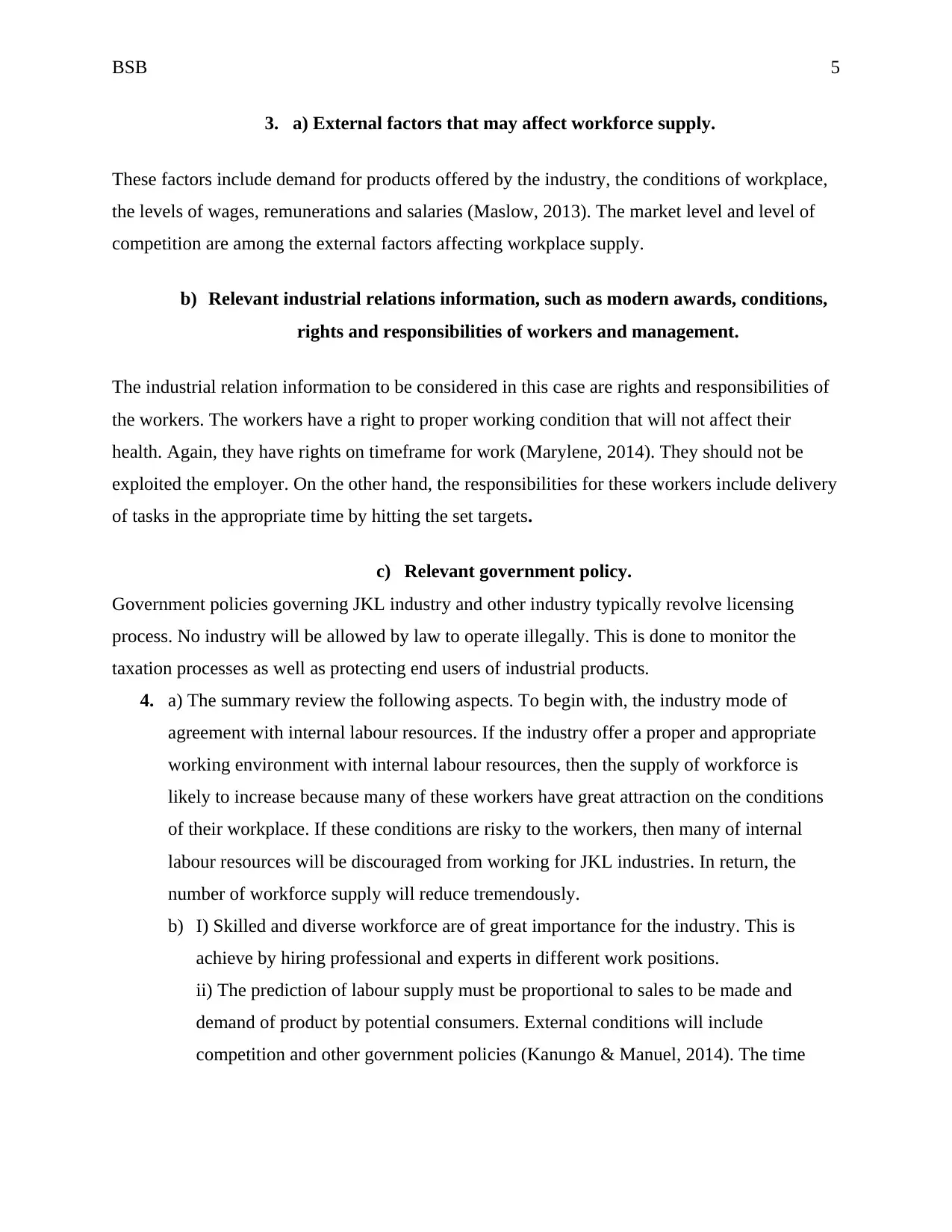
BSB 5
3. a) External factors that may affect workforce supply.
These factors include demand for products offered by the industry, the conditions of workplace,
the levels of wages, remunerations and salaries (Maslow, 2013). The market level and level of
competition are among the external factors affecting workplace supply.
b) Relevant industrial relations information, such as modern awards, conditions,
rights and responsibilities of workers and management.
The industrial relation information to be considered in this case are rights and responsibilities of
the workers. The workers have a right to proper working condition that will not affect their
health. Again, they have rights on timeframe for work (Marylene, 2014). They should not be
exploited the employer. On the other hand, the responsibilities for these workers include delivery
of tasks in the appropriate time by hitting the set targets.
c) Relevant government policy.
Government policies governing JKL industry and other industry typically revolve licensing
process. No industry will be allowed by law to operate illegally. This is done to monitor the
taxation processes as well as protecting end users of industrial products.
4. a) The summary review the following aspects. To begin with, the industry mode of
agreement with internal labour resources. If the industry offer a proper and appropriate
working environment with internal labour resources, then the supply of workforce is
likely to increase because many of these workers have great attraction on the conditions
of their workplace. If these conditions are risky to the workers, then many of internal
labour resources will be discouraged from working for JKL industries. In return, the
number of workforce supply will reduce tremendously.
b) I) Skilled and diverse workforce are of great importance for the industry. This is
achieve by hiring professional and experts in different work positions.
ii) The prediction of labour supply must be proportional to sales to be made and
demand of product by potential consumers. External conditions will include
competition and other government policies (Kanungo & Manuel, 2014). The time
3. a) External factors that may affect workforce supply.
These factors include demand for products offered by the industry, the conditions of workplace,
the levels of wages, remunerations and salaries (Maslow, 2013). The market level and level of
competition are among the external factors affecting workplace supply.
b) Relevant industrial relations information, such as modern awards, conditions,
rights and responsibilities of workers and management.
The industrial relation information to be considered in this case are rights and responsibilities of
the workers. The workers have a right to proper working condition that will not affect their
health. Again, they have rights on timeframe for work (Marylene, 2014). They should not be
exploited the employer. On the other hand, the responsibilities for these workers include delivery
of tasks in the appropriate time by hitting the set targets.
c) Relevant government policy.
Government policies governing JKL industry and other industry typically revolve licensing
process. No industry will be allowed by law to operate illegally. This is done to monitor the
taxation processes as well as protecting end users of industrial products.
4. a) The summary review the following aspects. To begin with, the industry mode of
agreement with internal labour resources. If the industry offer a proper and appropriate
working environment with internal labour resources, then the supply of workforce is
likely to increase because many of these workers have great attraction on the conditions
of their workplace. If these conditions are risky to the workers, then many of internal
labour resources will be discouraged from working for JKL industries. In return, the
number of workforce supply will reduce tremendously.
b) I) Skilled and diverse workforce are of great importance for the industry. This is
achieve by hiring professional and experts in different work positions.
ii) The prediction of labour supply must be proportional to sales to be made and
demand of product by potential consumers. External conditions will include
competition and other government policies (Kanungo & Manuel, 2014). The time
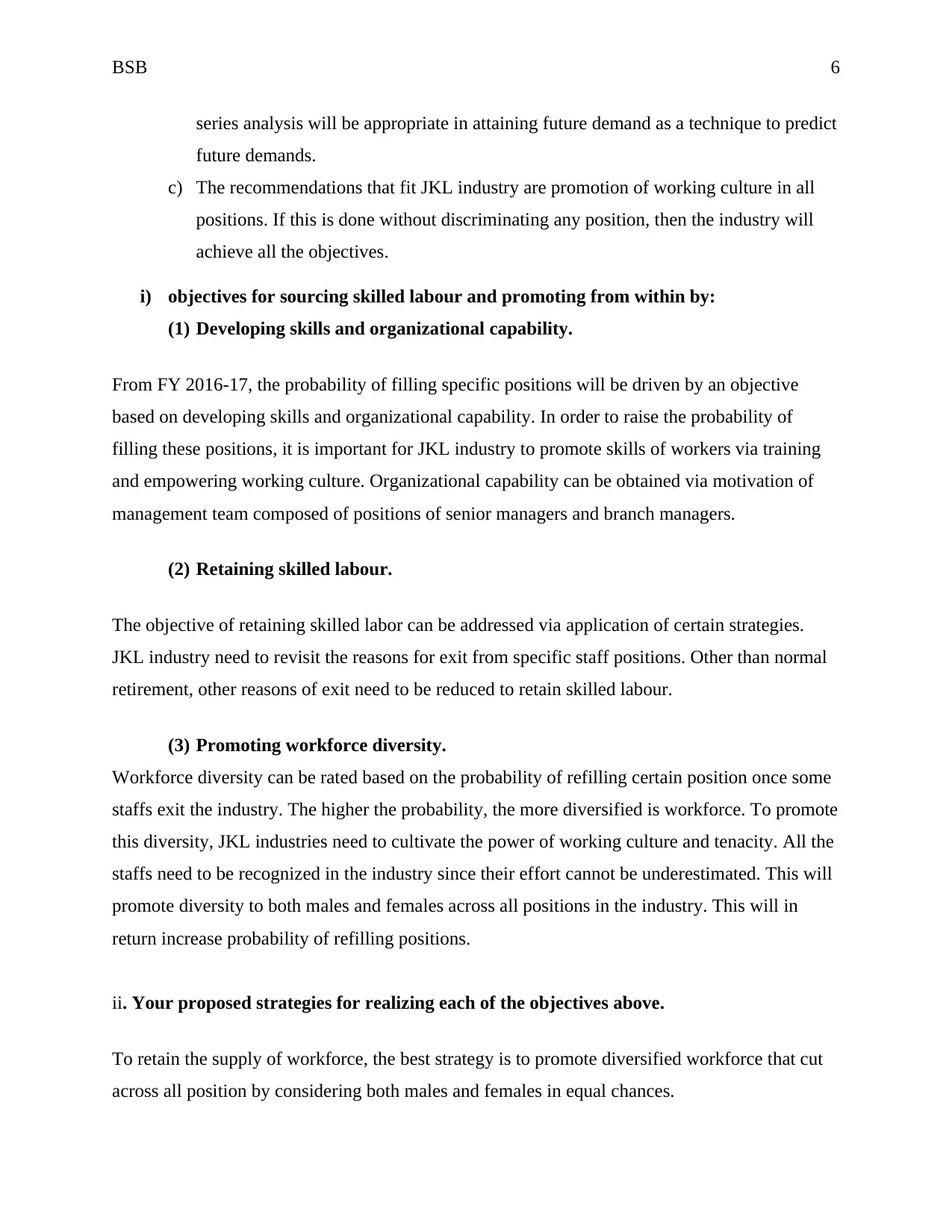
BSB 6
series analysis will be appropriate in attaining future demand as a technique to predict
future demands.
c) The recommendations that fit JKL industry are promotion of working culture in all
positions. If this is done without discriminating any position, then the industry will
achieve all the objectives.
i) objectives for sourcing skilled labour and promoting from within by:
(1) Developing skills and organizational capability.
From FY 2016-17, the probability of filling specific positions will be driven by an objective
based on developing skills and organizational capability. In order to raise the probability of
filling these positions, it is important for JKL industry to promote skills of workers via training
and empowering working culture. Organizational capability can be obtained via motivation of
management team composed of positions of senior managers and branch managers.
(2) Retaining skilled labour.
The objective of retaining skilled labor can be addressed via application of certain strategies.
JKL industry need to revisit the reasons for exit from specific staff positions. Other than normal
retirement, other reasons of exit need to be reduced to retain skilled labour.
(3) Promoting workforce diversity.
Workforce diversity can be rated based on the probability of refilling certain position once some
staffs exit the industry. The higher the probability, the more diversified is workforce. To promote
this diversity, JKL industries need to cultivate the power of working culture and tenacity. All the
staffs need to be recognized in the industry since their effort cannot be underestimated. This will
promote diversity to both males and females across all positions in the industry. This will in
return increase probability of refilling positions.
ii. Your proposed strategies for realizing each of the objectives above.
To retain the supply of workforce, the best strategy is to promote diversified workforce that cut
across all position by considering both males and females in equal chances.
series analysis will be appropriate in attaining future demand as a technique to predict
future demands.
c) The recommendations that fit JKL industry are promotion of working culture in all
positions. If this is done without discriminating any position, then the industry will
achieve all the objectives.
i) objectives for sourcing skilled labour and promoting from within by:
(1) Developing skills and organizational capability.
From FY 2016-17, the probability of filling specific positions will be driven by an objective
based on developing skills and organizational capability. In order to raise the probability of
filling these positions, it is important for JKL industry to promote skills of workers via training
and empowering working culture. Organizational capability can be obtained via motivation of
management team composed of positions of senior managers and branch managers.
(2) Retaining skilled labour.
The objective of retaining skilled labor can be addressed via application of certain strategies.
JKL industry need to revisit the reasons for exit from specific staff positions. Other than normal
retirement, other reasons of exit need to be reduced to retain skilled labour.
(3) Promoting workforce diversity.
Workforce diversity can be rated based on the probability of refilling certain position once some
staffs exit the industry. The higher the probability, the more diversified is workforce. To promote
this diversity, JKL industries need to cultivate the power of working culture and tenacity. All the
staffs need to be recognized in the industry since their effort cannot be underestimated. This will
promote diversity to both males and females across all positions in the industry. This will in
return increase probability of refilling positions.
ii. Your proposed strategies for realizing each of the objectives above.
To retain the supply of workforce, the best strategy is to promote diversified workforce that cut
across all position by considering both males and females in equal chances.
⊘ This is a preview!⊘
Do you want full access?
Subscribe today to unlock all pages.

Trusted by 1+ million students worldwide
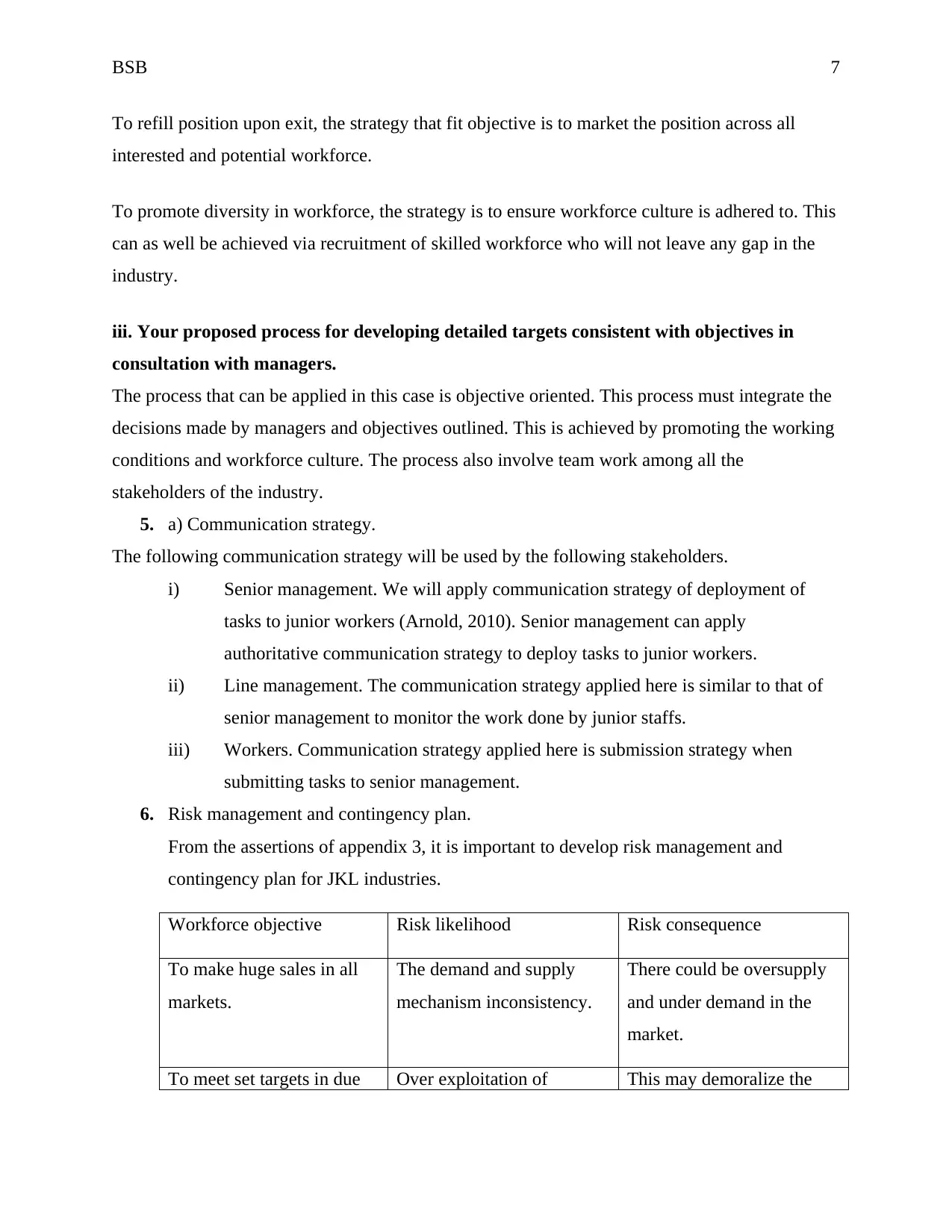
BSB 7
To refill position upon exit, the strategy that fit objective is to market the position across all
interested and potential workforce.
To promote diversity in workforce, the strategy is to ensure workforce culture is adhered to. This
can as well be achieved via recruitment of skilled workforce who will not leave any gap in the
industry.
iii. Your proposed process for developing detailed targets consistent with objectives in
consultation with managers.
The process that can be applied in this case is objective oriented. This process must integrate the
decisions made by managers and objectives outlined. This is achieved by promoting the working
conditions and workforce culture. The process also involve team work among all the
stakeholders of the industry.
5. a) Communication strategy.
The following communication strategy will be used by the following stakeholders.
i) Senior management. We will apply communication strategy of deployment of
tasks to junior workers (Arnold, 2010). Senior management can apply
authoritative communication strategy to deploy tasks to junior workers.
ii) Line management. The communication strategy applied here is similar to that of
senior management to monitor the work done by junior staffs.
iii) Workers. Communication strategy applied here is submission strategy when
submitting tasks to senior management.
6. Risk management and contingency plan.
From the assertions of appendix 3, it is important to develop risk management and
contingency plan for JKL industries.
Workforce objective Risk likelihood Risk consequence
To make huge sales in all
markets.
The demand and supply
mechanism inconsistency.
There could be oversupply
and under demand in the
market.
To meet set targets in due Over exploitation of This may demoralize the
To refill position upon exit, the strategy that fit objective is to market the position across all
interested and potential workforce.
To promote diversity in workforce, the strategy is to ensure workforce culture is adhered to. This
can as well be achieved via recruitment of skilled workforce who will not leave any gap in the
industry.
iii. Your proposed process for developing detailed targets consistent with objectives in
consultation with managers.
The process that can be applied in this case is objective oriented. This process must integrate the
decisions made by managers and objectives outlined. This is achieved by promoting the working
conditions and workforce culture. The process also involve team work among all the
stakeholders of the industry.
5. a) Communication strategy.
The following communication strategy will be used by the following stakeholders.
i) Senior management. We will apply communication strategy of deployment of
tasks to junior workers (Arnold, 2010). Senior management can apply
authoritative communication strategy to deploy tasks to junior workers.
ii) Line management. The communication strategy applied here is similar to that of
senior management to monitor the work done by junior staffs.
iii) Workers. Communication strategy applied here is submission strategy when
submitting tasks to senior management.
6. Risk management and contingency plan.
From the assertions of appendix 3, it is important to develop risk management and
contingency plan for JKL industries.
Workforce objective Risk likelihood Risk consequence
To make huge sales in all
markets.
The demand and supply
mechanism inconsistency.
There could be oversupply
and under demand in the
market.
To meet set targets in due Over exploitation of This may demoralize the
Paraphrase This Document
Need a fresh take? Get an instant paraphrase of this document with our AI Paraphraser
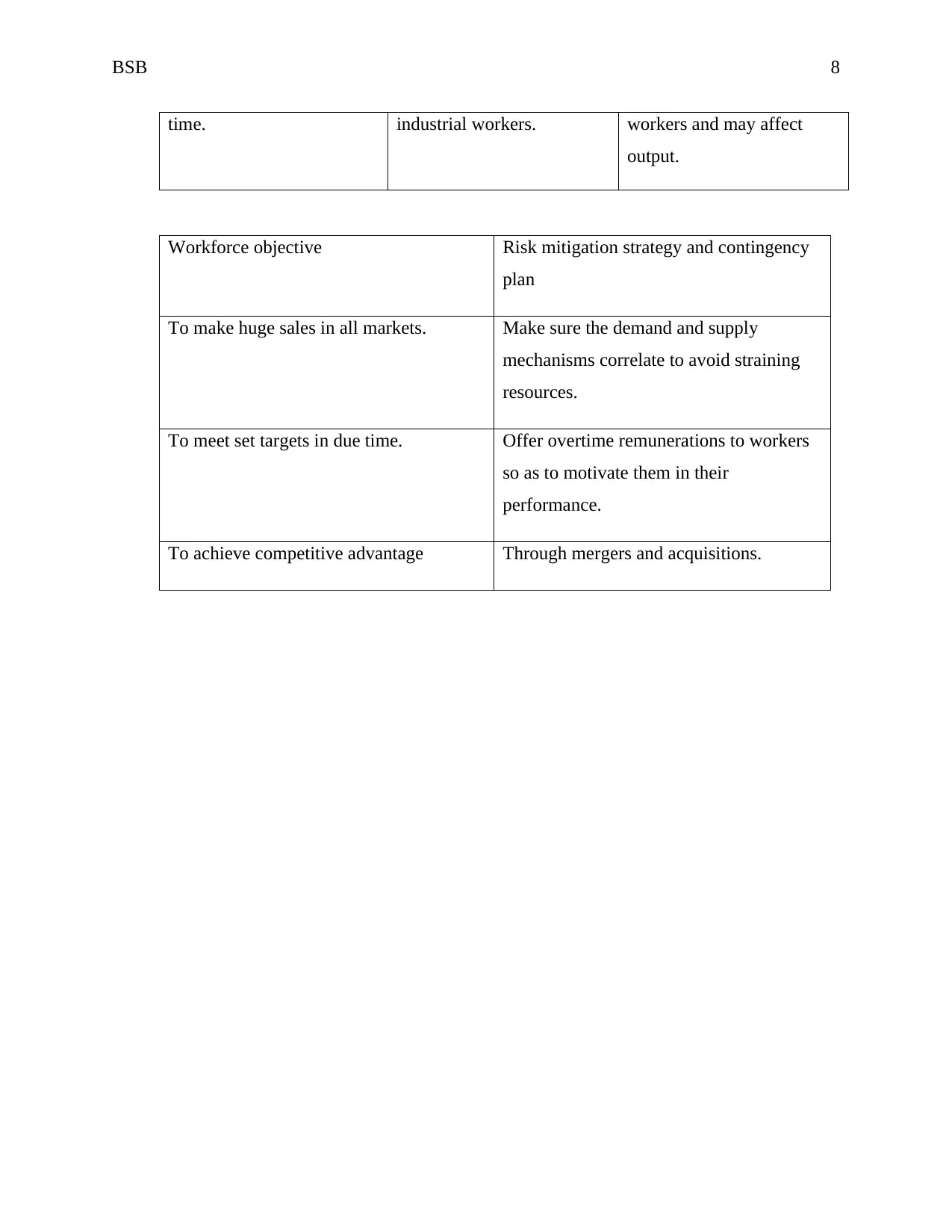
BSB 8
time. industrial workers. workers and may affect
output.
Workforce objective Risk mitigation strategy and contingency
plan
To make huge sales in all markets. Make sure the demand and supply
mechanisms correlate to avoid straining
resources.
To meet set targets in due time. Offer overtime remunerations to workers
so as to motivate them in their
performance.
To achieve competitive advantage Through mergers and acquisitions.
time. industrial workers. workers and may affect
output.
Workforce objective Risk mitigation strategy and contingency
plan
To make huge sales in all markets. Make sure the demand and supply
mechanisms correlate to avoid straining
resources.
To meet set targets in due time. Offer overtime remunerations to workers
so as to motivate them in their
performance.
To achieve competitive advantage Through mergers and acquisitions.
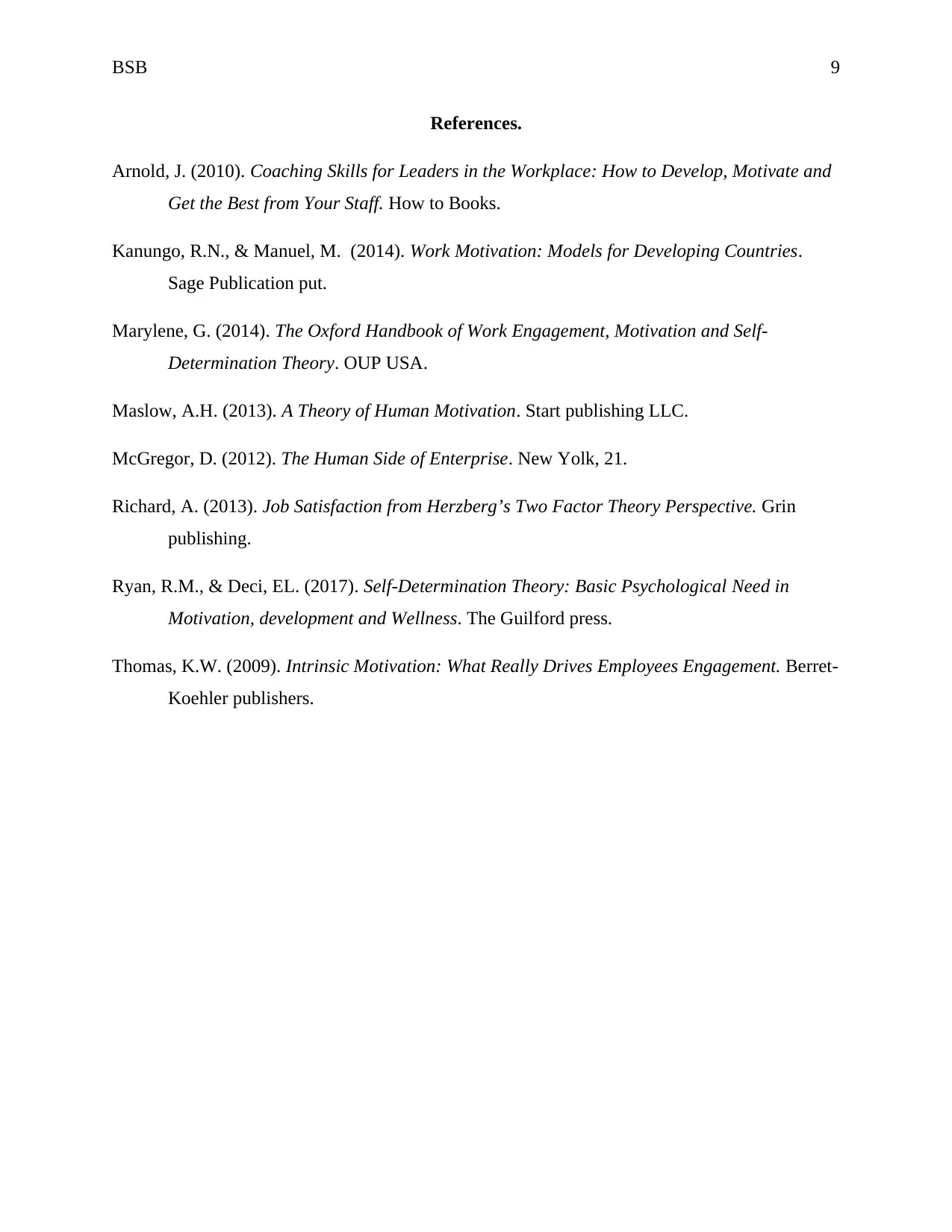
BSB 9
References.
Arnold, J. (2010). Coaching Skills for Leaders in the Workplace: How to Develop, Motivate and
Get the Best from Your Staff. How to Books.
Kanungo, R.N., & Manuel, M. (2014). Work Motivation: Models for Developing Countries.
Sage Publication put.
Marylene, G. (2014). The Oxford Handbook of Work Engagement, Motivation and Self-
Determination Theory. OUP USA.
Maslow, A.H. (2013). A Theory of Human Motivation. Start publishing LLC.
McGregor, D. (2012). The Human Side of Enterprise. New Yolk, 21.
Richard, A. (2013). Job Satisfaction from Herzberg’s Two Factor Theory Perspective. Grin
publishing.
Ryan, R.M., & Deci, EL. (2017). Self-Determination Theory: Basic Psychological Need in
Motivation, development and Wellness. The Guilford press.
Thomas, K.W. (2009). Intrinsic Motivation: What Really Drives Employees Engagement. Berret-
Koehler publishers.
References.
Arnold, J. (2010). Coaching Skills for Leaders in the Workplace: How to Develop, Motivate and
Get the Best from Your Staff. How to Books.
Kanungo, R.N., & Manuel, M. (2014). Work Motivation: Models for Developing Countries.
Sage Publication put.
Marylene, G. (2014). The Oxford Handbook of Work Engagement, Motivation and Self-
Determination Theory. OUP USA.
Maslow, A.H. (2013). A Theory of Human Motivation. Start publishing LLC.
McGregor, D. (2012). The Human Side of Enterprise. New Yolk, 21.
Richard, A. (2013). Job Satisfaction from Herzberg’s Two Factor Theory Perspective. Grin
publishing.
Ryan, R.M., & Deci, EL. (2017). Self-Determination Theory: Basic Psychological Need in
Motivation, development and Wellness. The Guilford press.
Thomas, K.W. (2009). Intrinsic Motivation: What Really Drives Employees Engagement. Berret-
Koehler publishers.
⊘ This is a preview!⊘
Do you want full access?
Subscribe today to unlock all pages.

Trusted by 1+ million students worldwide
1 out of 9
Related Documents
Your All-in-One AI-Powered Toolkit for Academic Success.
+13062052269
info@desklib.com
Available 24*7 on WhatsApp / Email
![[object Object]](/_next/static/media/star-bottom.7253800d.svg)
Unlock your academic potential
Copyright © 2020–2025 A2Z Services. All Rights Reserved. Developed and managed by ZUCOL.





